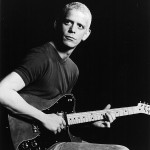-
Featured News
Patti Smith Upcoming Tour for 50th Anniversary of Horses
 By Harvey Kubernik
“Horses was like the first cannon blast in a war – frightening and disorienting. I mean, she was so unlike the FM radio terrain in every way. She was literate, aggress
By Harvey Kubernik
“Horses was like the first cannon blast in a war – frightening and disorienting. I mean, she was so unlike the FM radio terrain in every way. She was literate, aggress -
Featured Articles
Chasing the White Light: Lou Reed, the Telepathic Secretary and Metal Machine Music
 By David Holzer
Fifty years ago, Lou Reed released Transformer. In among “Walk on the Wild Side,” “Make Up” and “Vicious,” cuts that would launch a cartoon Rock N Roll Animal pers
By David Holzer
Fifty years ago, Lou Reed released Transformer. In among “Walk on the Wild Side,” “Make Up” and “Vicious,” cuts that would launch a cartoon Rock N Roll Animal pers -
Pete Cosey 1943-2012
By Eric Colin Reidelberger
Few guitarists are more underappreciated than the big man, Pete Cosey. An incomparable aural trailblazer and avid woodshedder who blew the doors off every entrance he made. As a wide-open player who employed many musical “systems” (as he called them) he preferred bridges to barriers and played with jazz, country, frat rock and blues bands alike, when that practice was purely unheard. He was a session man, manipulator of chord progressions and such a wild experimentalist that Miles Davis once told him that he “…wrote differently than anyone he’d heard.” It’s with hope that there are more extant sides to arrive from this mountain of a man, both physically and as an institution. Below Sir Eric Colin gives lip service to the man’s history and prowess, plus I’ve included a playlist of some of Cosey’s contributions. What’s your fave-rave? (jeremy nobody, esq.)
Pete Cosey’s name might not have been at the tip of everyone’s tongue, but if you owned any records on the Chess label from the late ’60s or dug your heels into any of Miles Davis’ grand wigouts, then chances are you are probably familiar with his handiwork. A sonic adventurer that boldly went where only a few dare tread, finding the continuity between Jazz, Funk and Psychedelic Rock and trailblazing his own pathway to the nether regions.
Born in Chicago, Illinois, in 1943 and after living his teenage years in Phoenix, Arizona, Pete cut his teeth as a session player in the ’60s/early ’70s back in Chicago for Chess Records. He played on numerous sessions (often uncredited) by artists such as Etta James, Chuck Berry, Gene Ammons, Sonny Stitt, Rotary Connection and the polarized electric periods of both Howlin’ Wolf and Muddy Waters. Adding a surfeit of effects, including a wonderful preponderance of wah-wah/fuzz acrobatics, Pete managed to completely horrify blues purists in one fell swoop, and gather quite an audience of heads who would go on to champion his bold explorations in the years to come.
Cosey was a truly inventive and original player who was obviously influenced by Hendrix’s stylings, but taking the proceedings into an almost unhinged free jazz territory akin to similar giant steps taken by fellow traveler Sonny Sharrock. He was an embryonic member of Chicago Afro Funk behemoths The Pharoahs who later became the seeds of Earth, Wind & Fire, as well as exploring some spiritual journeys with Philip Cohran. Pete is best remembered for the four albums he played on under Miles Davis’ solid-band leading hand: Get Up With It, Pangea, Agharta and Dark Magus.
It is here and in such stellar company that his creative being was given the proper chance to flourish; often pushing the music (and perhaps) the musicians into fever pitch territory.
After the breakup of the Miles band in 1975, Pete kept a relatively low profile, only rearing his head here and there in the years afterwards, most notably playing on the title track to Herbie Hancock’s Future Shock. On May 30, 2012 in Chicago, after complications with surgery, the world lost yet another major musical talent who really wasn’t given the proper credit of the true sonic pioneer he was.
From our current issue, Ugly Things #33, jeremy nobody, esq. reviews one of the grand experiments Cosey contributed to: This Is Howlin’ Wolf’s New Album: https://ugly-things.com/reviews/albums/

джой казино 2016
[url=http://cmkl.ru/]джойказино[/url] joycasino вывод денег
джойказино
کفسابی و سنگسابی و نماشویی برتر
is in reality a wonderful and beneficial piece of data. I¡¦m content that you just shared this valuable information with us. You should keep us up to day like this. Many thanks for sharing.
canadian pharmacy online viagra
[url=http://viagracanadiantousa.com/]cialis sales canada[/url]
buying from viagra canada
viagra canada
cialis sales canada
joycasino com официальный сайт джойказино
[url=http://cmkl.ru/]джой казино сом[/url] 128 joycasino com
джойказино
adam and eve
[...]here are some hyperlinks to sites that we link to simply because we feel they’re really worth visiting[...]
cheap viagra from canada
[url=http://viagracanadiantousa.com/]cheap viagra in canada[/url]
buy viagra online canada pharmacy
order cialis from canada
canada viagra online pharmacy
Howdy, what do you feel regarding latest framaroot? Pretty fascinating issue, huh?
sex poker
[...]one of our guests just lately recommended the following website[...]
diflucan antibiotics together
[url=http://buydiflucancvv.com/]buy diflucan over the counter[/url]
buy diflucan online canada
diflucan mycomax cena